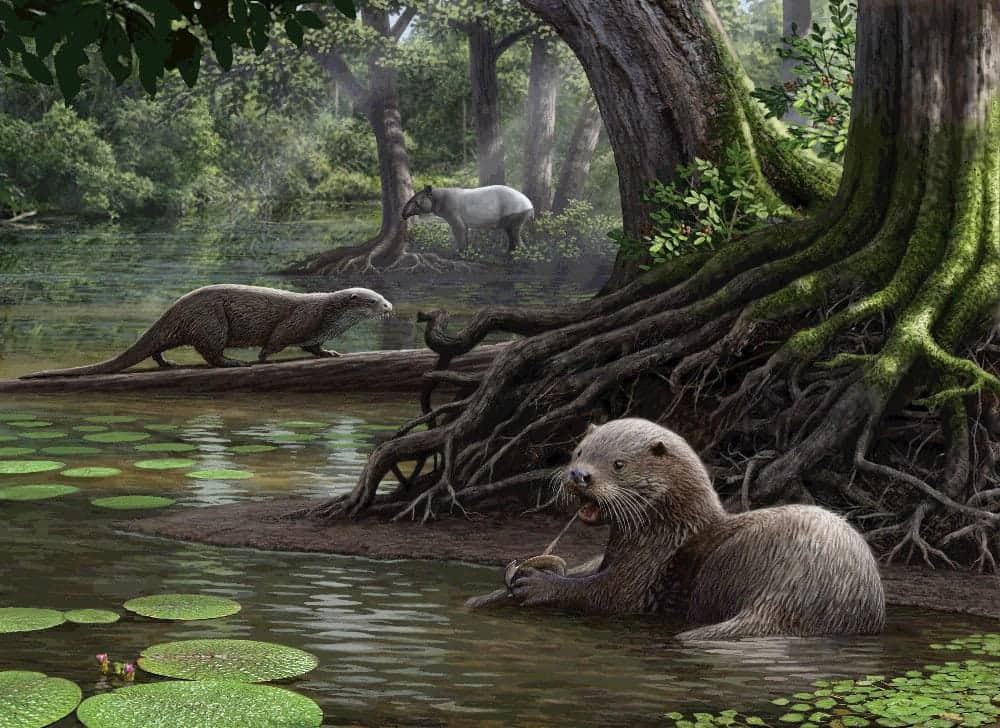
Artist's reconstruction of two individuals of Siamogale melilutra sp. nov., one of them feeding on a freshwater clam. The tapir in the background is Tapirus yunnanensis. Aquatic plants include water chestnut (Typha) and fox nut (Euryale) and the low shrub in foreground is Sichuan peppercorn (Zanthoxylum). See National News story NNOTTER: A wolf-sized otter weighing close to eight stones once roamed the Earth's ancient swamps, a new study revealed. The ancient species was almost as twice as large of present day otters and had features similar to an otter and a badger. It also had powerful jaws to crunch large shellfish and freshwater mollusks which would have been their main food. The otter named Siamogale melilutra lived some six million years ago and belongs to an ancient lineage of extinct otters, which goes back at least 18 million years.
A wolf-sized otter weighing close to eight stones once roamed the Earth’s ancient swamps, a new study revealed.
The ancient species was almost as twice as large of present day otters and had features similar to an otter and a badger.
It also had powerful jaws to crunch large shellfish and freshwater mollusks which would have been their main food.
The otter named Siamogale melilutra lived some six million years ago and belongs to an ancient lineage of extinct otters, which goes back at least 18 million years.
Previously the only examples were isolated teeth recovered from Thailand until paleontologist found more fossilised remains at Shuitangba in the Yunnan Province,
Southwestern China.
Scans revealed a complete cranium, mandible, dentition and various skeletal elements sheds light on the evolution of the little known fossil genus of the otter family.
Curator & Head of Paleobotany and Paleoecology Dr Denise Su at the Cleveland Museum of Natural History said: “Otters (subfamily Lutrinae) are semi-aquatic predators in the family Mustelidae.
“Modern otters have a worldwide distribution but their fossil record is poor, often consisting of fragmentary jaws and teeth.
“Multiple lineages have developed bunodont dentitions with enlargements of molars, usually for cracking molluscs or other hard foods.
“Some lineages have evolved badger-like teeth and, as a result, were often confused with melines (Old World badger clade).”
“From the vegetation and other animal groups found at Shuitangba, we know that it was a swampy, shallow lake with quite dense vegetation.
“While the cranium is incredibly complete, it was flattened during the fossilisation process.
“The bones were so delicate that we could not physically restore the cranium.
“Instead, we CT-scanned the specimen and virtually reconstructed it in a computer,”
The CT scans revealed a combination of otter-like and badger-like cranial and dental feature.
Because of this its species name was called “melilutra,” derived from meles, Latin for badger and lutra, Latin for otter.
Lead author Curator and Head of Vertebrate Palaeontolog Dr Xiaoming Wang at the Natural History Museum of Los Angeles County said: “Multiple otter lineages have low-crowned, bunodont teeth, leading us to ask the question if this was inherited from a common ancestor or if this was convergent evolution based on common dietary behaviours across different species
“Our phylogenetic analysis suggests that bunodont dentition independently appeared at least three times over the evolutionary history of otters.”
“The discovery of the otter helps solve some questions about otter relationships, but
has opened the door to new questions
“For instance, why was it so large, how did it crack open mollusks and shellfish for
food, and how did it move in the water and on land?”
Dr Su added: “Continued future studies by our group will address these fundamental questions and give us a more complete picture of its paleobiology.”
The study was published in the Journal of Systematic Paleontology.